Overview
Welcome to the Auditory and Communication Systems Laboratory at Duke. Our research aims to understand the behavioral and brain mechanisms underlying hearing and vocal communication in both basic science and translational models.
The Auditory and Communication Systems Laboratory is recruiting students and post-docs
If you are interested, contact:
steven.eliades AT duke.edu
Lab News
Jan 2023, Welcome to 2 new lab members! Weisong Ong returns to Duke as a Research Associate in the lab. Shouyi Li is a rotation student from Neurobiology.
Nov 2022, Lab members attended SfN. Had a great time, but with two satellite symposiums (and the marmoset social !) it was exhausting.
Oct 2022, Welcome to Rene Carter, a rotation student in Neurobiology. Rene is interested in possible animal models of psychiatric disease.
Aug 2022, Lab members joined a strong Duke contingent at the Gordon Research Conference on Acoustic Communication. Learned a lot and had a great time.
July 2022, Welcome to Connor Pratson, an ENT resident doing an exciting clinical project looking at clustering of vestibular testing.
June 2022, Welcome to Justine Shih, a rotation student from CNAP. Justine is trying figure out if we can use STRFs to determine receptive fields during naturalistic hearing.
April 2022, Lab members presented several talks at the 'Combined Otolaryngology Society Meeting' (COSM) in Dallas. Probably the first time the word 'marmoset' was ever heard at that venue, hopefully not the last
April 2022, There was a meeting of US marmoset labs in Boulder CO to formulate strategic plans for US marmoset research and supply.
March 2022, Welcome to Ana Anguiano our new lab technician and manager.
Feb 2022, The lab has relocated to Duke! Very excited for the new opportunities.
Dec 2018, A new book on marmosets was published, "The Common Marmoset in Research and Captivity." Joji and Steve Wrote the auditory chapter. (I know this is old, but its an important reference).
Research
Our research aims to understand brain and behavioral mechanisms involved in auditory perception and vocal communication. We are interested in how different brain areas are involved in processing the sounds that we hear. We are particularly interested in how these different brain regions interact to help support vocal communication, a complex process that involves both production and perception of communication sounds. Such communication behaviors are important for the survival of a species, and understanding them can yield important insight into human communication ncluding speech and language. We approach these problems using multiple approaches, including research in both humans and vocal primates, combining neurophysiologic techniques with behavioral measurements, computational tools, and engineering approaches.
Current Projects
Neural basis of auditory-self monitoring and vocal production (auditory-vocal interaction)
Humans continuously monitor the sound of our speech to ensure accurate vocal production, a process known as self-monitoring, The neural mechanisms of this control are largely unknown. We record neural activity in both auditory and frontal cortex during communicative vocal production, and perturb auditory feedback with headphones. We examine the relationship between cortical activity and self-monitoring and compensatory vocal control. We also manipulate cortical circuits to see if we can change vocal production behaviors. We are particularly interested in the idea of sensory prediction during vocal production, and how the brain might calculate an auditory 'error signal' that tells us when our voice doesn't match what we expected.
Brain mechanisms of auditory self-monitoring during human speech
Despite advances in understanding vocal production in animal models, the relationship to more complicated human speech is unclear. In conjunction with collaborators in Neurosurgery, we investigate brain activity in human neurosurgical patients undergoing monitoring as part of their clinical treatment. In parallel to our animal work, we examine the role of different brain areas during speech production, allowing direct comparisons of human speech and animal vocalization. We are really excited to ask questions about self-perception that we can't ask in animals, for example: how do you know if that voice you heard was yourself? Its a question about metacognition, and is not well understood in the auditory/vocal field.
Neural coding of communications sounds in complex, naturalistic environments
Our current understanding of neural coding of complex sounds is based upon responses to sounds delivered in carefully controlled conditions. It has recently become clear that behavioral context strongly modulates neural coding at the cortical level. We record neural activities during interactive vocal communication in behaviorally relevant, naturalistic environments (akin to doing an experiment by recording everything one hears in day-to-day life). We examine the effects this context has both on low-level sensory processing, but also on how neural activity supports vocal decision masking in complex social situations.
Marmoset social communication
Marmosets have a rich vocal repertoire and complex social interactions. How do they coordinate their conversations between large groups? Does the high degree of variability in their vocal sounds convey information? Understanding these questions may give us some insight into the evolutionary origins of human social communication. We use multi-animal behavioral recording to try and construct a model of the 'social network' between animals and answer these questions. We hope to ultimately pair this with video recording of visual/postural communication as well as neural recoding to gain better understanding of the 'social brain.'
Marmosets as a neurologic and psychiatric disease model
Important insights have been gained into human neurologic and psychiatric disease based upon rodent models. Rodents, while excellent and convenient models, often lack many of the rich social and communicative behaviors seen in humans that are often affected by these disease. Marmosets offer the potential of a convenient middle ground. For example, self-monitoring and auditory-vocal interaction in the brain appear to be dysfunctional in schizophrenia, and are thought by some to be the origin of auditory hallucinations. Our preliminary work suggests that we can temporarily reproduce much of this dysfunction using commonly available medications, and may yield valuable insights into the disorder.
Cochlear implant-related cortical plasticity
Despite decades of clinical use, the effects of cochlear implantation (CI) on the brain of recipients are poorly understood. Plasticity in the cortex is thought to affect performance of CI users, but has not been studies. We plan to chronically record cortical neural activity following cochlear implantation to better understand the long-term effects on neural processing, in the hopes of designing better rehabilitation and CI programming strategies.
Clinical and Translational Research
Feedback-dependent speech control in hearing loss and communication disorders
Similar to our basic science models, we are interested in how patient populations are able to listen to the sound of their own voice, and use this auditory feedback to help control their speech and voice. We record the speech production of different while changing what they hear of their own voice. We have previously tested patients with cochlear implants and those with spasmodic dysphonia. This will allow us to develop better strategies to help patients with hearing loss improve their speech, and will also yield better insight into the underlying mechanisms of speech motor control.
Neural coding and auditory performance in cochlear implant patients
Patients who receive cochlear implants (CI) have to learn to use their implant, a process that can take a year or more to achieve. How the brain accomplishes this and how we can improve this is unclear. We have begun examining patient level factors that might affect learning and plasticity, and are discussions with collaborators in psychology and engineering to see how we can better measure and modulate the learning process. We are also working with industry to see how implant placement and programming, in particular pitch-place mismatches, might affect outcomes.
Vestibular testing and diagnoses
Patient who have dizziness and balance complaints will often undergo a battery of physiologic tests to try and better understand the causes of their symptoms and to aid in diagnosis. Not surprisingly, these tests are imperfect and results often conflict with one another. We are using quantitative analytic approaches to see how often results disagree, and determine if those patterns can help better diagnose patients.
People
Post-doctoral Fellows & Research Associates
Joji Tsunada, DVM, Ph.D. (Joji has moved on, but still remains active in lab collaborations and projects)
email: jtsunada(at)cibr.ac.cn
Undergraduate students
Jean Chuang (Undergraduate research assistant, Neuroscience - Fall 2022)
Lab manager and research technicians

Ana Anguiano (Lab Manager)
email: ana.anguiano AT duke.edu
Collaborators
Duke
Richard Mooney, PhD
Department of Neurobiology
Greg Cogan, PhD
Department of Neurology
Greg Pearson, PhD
Department of Neurobiology
Michael Tadross, PhD
Department of Biomedical Engineering
>Marc Sommer, PhD
Department of Biomedical Engineering
Sherri Smith, PhD, AUD
Department of Head and Neck Surgery & Communication Sciences
Kristal Riska PhD, AUD
Department of Head and Neck Surgery & Communication Sciences
University of Pennsylvania
Yale Cohen, PhD
Auditory Research Laboratory, Penn Department of Otorhinolaryngology
Maria Geffen, PhD
Laboratory of Auditory Coding, Penn Department of Otorhinolaryngology
Diego Contreras, PhD
Penn Department of Neuroscience
Michael Ruckenstein, MD and Jason Brant MD
Center for Implantable Hearing Devices, Penn Department of Otorhinolarynology
Johns Hopkins
Xiaoqin Wang, PhD
Lab of Auditory Neurophysiology, Johns Hopkins University
Dana Boatman-Reich, PhD
Clinical and Computational Auditory Neuroscience Lab, Johns Hopkins University
Former lab members
Tammi Coleman (lab manager, alas stayed at Penn when the lab moved)
Joji Tsunada PhD (post-doctoral fellow, research associate, Currently faculty at the Chinese Institute for Brain Research)
Arthur Thomas (medical student)
Anirudh Ghautam (visiting medical student)
Annant Kumar. (undergraduate research assistant, Computer Science)
Elizabeth Kim (undergraduate research assistant, Biology)
Peter Sayde (lab tech, went on to medical school at LSU)
Grace Tan, MD (medical student, went on to residency in Otolaryngology, Johns Hopkins Hospital)
Nathalie Kahn (post-bac student , went on to medical school at Thomas Jefferson University School of Medicine)
Benjamin Ballintyn (undergraduate student, Neuroscience, went on to PhD program in computational neuroscience at Brandeis University)
Kevin Hayes (undergraduate student, BME)
Rotation students
Shouyi Li (Neurobio, Winter 2023)
Rene Carter (Neurobio, Fall 2022)
Justine Shih (CNAP, Summer 2022)
Publications
Eliades SJ and Tsunada J. Effects of cortical stimulation on feedback-dependent vocal control in non-human primates. Laryngoscope, 2022 (doi: 10.1002/lary.30175)

Summary: In this article, we followed up on our 2018 paper using electrical microstimulation in auditory cortex. Here we examined whether the stimulation not only affected normal vocal production, but could interfere with the feedback-depending pitch control. We found that we could indeed affect the pitch reflex, blocking/reducing it if the stimulation site had frequency tuning near the vocal range, and actually enhancing the reflex if more distant. Read more ...
Thomas A, Mirza N, Eliades SJ. Auditory feedback control of vocal pitch in spasmodic dysphonia. Laryngoscope, 131: 2070-2075, 2021
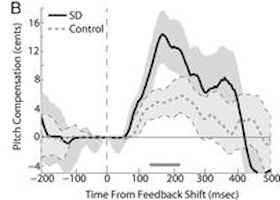
Summary: Spasmodic dysphonia (SD) is a vocal disordered characterized by vocal breaks during phonation. It is thought of as a focal dystonia, though its origins is unclear. Here we tested vocal pitch control in SD patients and normal controls, and found SD patients had increased pitch reflexes, suggesting a hyperactive reflex. Interestingly, there was an inverse correlation with subjective symptoms, i.e. those that were most bothered by their symptoms had the most normal pitch control. These findings may give us some new approaches to managing SD. Read more ...
Gautam A, Brant JA, Ruckenstein M, Eliades SJ. Real-time feedback control of voice in cochlear implant recipients. Laryngoscope Inv Oto. 5: 1156-1162, 2020
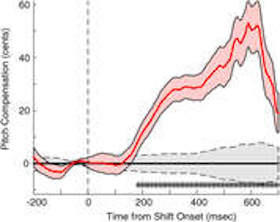
Summary: In this clinical/translational study, we examined whether cochlear implant patients had the same feedback control of vocal pitch as normal individuals (and our marmosets). We found that they did, but we had to push the feedback to almost half an octave to get them to compensate! Perhaps not surprising given the poor frequency resolution of cochlear implant. Interestingly, when they did compensate, it was larger than normal individuals. This could be because, unlike normal hearing subjects, they could not hear direct feedback or bone-conductive feedback without the pitch shift. Read more ...
Eliades S and Tsunada J. Dissociation of unit activity and gamma oscillations during vocalization in primate auditory cortex. J. Neurosci, 40: 4158-4171, 2020

Summary: Gamma oscillations have been described to reflect the activity of local inhibitory interneurons in the cortex. Here we showed that sites with strong vocal suppression also exhibit increased gamma oscillations, consistent with vocalization-induced suppression as a local cortical phenomenon rather than one inherited from subcortical pathways. These findings allow us to dissociate contributions of sensory inputs from putative top-down motor inputs, and also suggest possible circuit mechanisms within the cortex. Read more ...
Eliades SJ and Wang X. Corollary discharge mechanisms during vocal production in marmoset monkeys. Biological Psychiatry: Cog Neurosci and Neuroimaging, 4: 805-812, 2019.
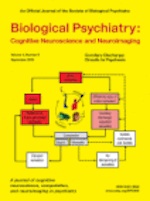
Summary: This review was part of a special issue looking at corollary discharge mechanisms in both humans and animals, with a focus of dysfunction in neuropsychiatric disease. Read more...
Eliades SJ and Tsunada J. Auditory cortical activity drives feedback-dependent vocal control in marmosets. Nature Communications, 9, 2018 (DOI 10.1038/s41467-018-04961-8)
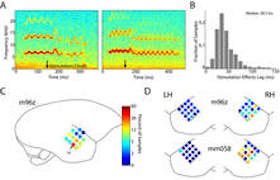
Summary: While the suppression of auditory cortex during human speech and animal vocal production has been well established, what behavioral role the auditory cortex actually plays to support vocal communication has been unclear. In this study we show that marmosets exhibit real-time feedback control of their vocalization frequencies, almost identically to human speech pitch control. Neurons in the auditory cortex actually predict this compensatory behavior before it happens. Finally, we used microstimulation of the auditory cortex and found that causes marmosets to rapidly (40ms !) change their vocalizations (illustrated left). This is the first critical and causal evidence for a behavioral role for the auditory cortex in vocal production. Read more...
Eliades SJ and Miller CT. Marmoset vocal communication: Behavior and neurobiology. Dev Neurobiol, 77: 286-299, 2017
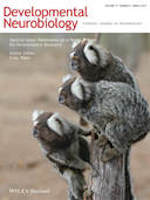
Summary: This review was part of a special issue on Marmosets in biomedical research, spanning the whole range of fields from behavior, to genetics, to neuroscience. We highly recommend anyone interested in neuroscience go to the Developmental Neurobiology website and take a look at the whole issue! Read more...
Eliades SJ and Wang X. Contributions of sensory tuning to auditory-vocal interactions in marmoset auditory cortex. Hearing Res, 348: 98-111, 2017

Summary: This study reports on new-analysis of previous marmoset vocal production results, to examine what role sensory tuning in auditory cortex may have in neural responses during vocal production. We found that excited responses during vocalization are predictable based upon sensory tuning, but suppressed responses are not, consistent with suppression as a sensory-motor process rather than a purely sensory one. Read more...
Eliades SJ, Crone NE, Anderson WS, Ramadoss D, Lenz FA, and Boatman-Reich D. Adaptation of High-Gamma Responses in Human Auditory Association Cortex. J Neurophysiol 112: 2147-2163, 2014
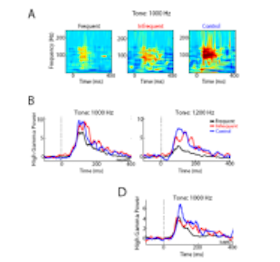
Summary: This study reports on findings of adaptation of auditory responses recorded intracranialy from human subjects using ECoG. We show that human auditory cortex responses, like those of animals, adapt with repetitive auditory stimulation. Unlike many scalp recorded EEG studies, we do not find evidence of a novelty of mismatch response when appropriate controls are used. Read more...
Ghazanfar AA and Eliades SJ. The neurobiology of primate vocal communication. Curr Opinion in Neurobiology 28: 128-135, 2014
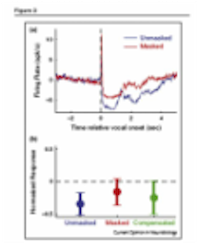
Summary: Recent investigations in non-human primate communication has revealed vocal behaviors for more complex than previously appreciated. Understanding the neural basis of these communicative behaviors is important as it has the potential to reveal the basic underpinnings of still more complex human speech. Here we summarize recent behavioral and physiologic investigations into primate vocal communication. Read more...
Eliades SJ and Wang X. Comparison of auditory-vocal interactions across multiple types of vocalizations in marmoset auditory cortex. J Neurophysiol 109: 1638-1657, 2013
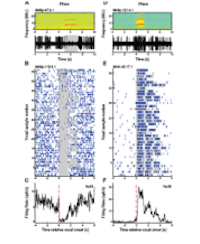
Summary: Auditory-vocal interaction, the modulation of auditory sensory responses during vocal production, is a poorly understood neurophysiological phenomenon in both humans and non-human primates. This sensory process likely lays a role in auditory-self monitoring during vocal production, and feedback-mediate vocal control. Previous studies have largely focused on a single type of vocalization. Here we examine auditory-vocal interactions across multiple classes of marmoset vocalizations and find that vocalization-related responses are often similar regardless of the type of vocalization produced. Read more...
Positions
The lab is currently looking to bring on another post-doc. Please contact Dr Eliades (email below).
We are currently seeking graduate students interested in studying auditory physiology, animal behavior, neural computation, or cochlear implants.
We have openings of undergraduate students interested in getting involved in cutting-edge neuroscience research.
Medical students, are you looking for a research project? We have several ongoing clinical projects just looking for your help.
Interested in a position, contact Dr. Eliades (steven.eliades AT duke.edu)
Contact
Our laboratory is located in the Bryan Research Building at the Duke University School of Medicine.
We are in the Department of Head and Neck Surgery and Communication Sciences and is affiliated with the Department of Neurobiology and the Duke Institute for Brain Sciences (DIBS).
Mailing Address
Dr. Steven Eliades
40 Duke Medicine Circle
DUMC Box 3805
Durham, NC 2710
Tel: 919-684-6968
Fax: 919-681-6881
email: steven.eliades AT duke.edu
Patients / Clinical Contact Information
Are you a patient interested in a referral or needing to get in touch with Dr. Eliades?
call: 919-684-2426 or 919-944-4357 (appointments)
fax: 919-684-858
If this is an after hours urgent clinical issue, please call 919-684-8111 and ask to speak to the on-call resident.
Interested in a clinical research study?
contact Dr. Eliades at: steven.eliades ATduke.edu